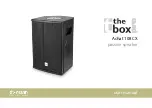
7
RQ
TX10
24
Getting S
tarted
Quick Start
Gu
ide
E
N
GLIS
H
Basic setup example
[\\\\\\\\\\\HDMI\AV\OUT\\\\\\\\\]
This connection provides the best picture quality.
Connect the HDMI cable (not included) from the HDMI AV OUT
terminal on the main unit to the HDMI AV IN terminal on your TV.
≥
Set “VIDEO PRIORITY” to “ON” (
B
16, HDMI menu).
≥
Set “VIDEO FORMAT” in Menu 4 (HDMI) (
B
13).
VIERA Link “HDAVI Control”
If your Panasonic TV is VIERA Link compatible, you can operate your
TV synchronising with home theater operations or vice versa (
B
13,
Using the VIERA Link “HDAVI Control
TM
”).
≥
Make the extra audio connection (
B
right) when you use VIERA Link
“HDAVI Control” function.
[Note]
≥
Non-HDMI-compliant cables cannot be utilized.
≥
It is recommended that you use Panasonic’s HDMI cable.
Recommended part number:
RP-CDHG15 (1.5 m),RP-CDHG30 (3.0 m), RP-CDHG50 (5.0 m), etc.
≥
For TV with more than one HDMI terminal, refer to the operating
instructions for the TV to determine which terminal to connect to.
≥
Do not make the video connections through the VCR.
Due to copy guard protection, the picture may not be displayed
properly.
≥
Only one video connection is required. Choose one of the video
connections above depending on your TV.
[\\\\\\\\\AUX/TV\\\\\\\\]
This connection enables you to play audio from your TV, STB or VCR
through your home theater system (
B
9, Selecting the source by the
remote control).
Connect the audio cable (not included) from the AUX/TV terminal
on the main unit to the AUDIO OUT terminal on your TV.
[Note]
If you have various sound sources (such as Blu-ray player, DVD
recorder, VCR, etc.), connect them to the available inputs on the TV and
the TV output should then be connected to the AUX/TV terminal of the
main unit.
Conserving power
The main unit consumes a small amount of power, even when it is in
standby mode (approx. 0.48 W). To save power when the unit is not to
be used for a long time, unplug it from the household mains socket.
You will need to reset some memory items after plugging in the main
unit.
[Note]
The included AC mains lead is for use with the main unit only.
Do not use it with other equipment. Also, do not use cords for other
equipment with the main unit.
Do not:
≥
mix old and new batteries.
≥
use different types of batteries at the same time.
≥
take apart or short circuit.
≥
attempt to recharge alkaline or manganese batteries.
≥
use batteries if the covering has been peeled off.
Mishandling of batteries can cause electrolyte leakage which can
severely damage the remote control.
Remove the batteries if the remote control is not going to be used for a
long period of time. Store in a cool, dark place.
Aim at the remote control signal sensor (
B
4), avoiding obstacles, at a
maximum range of approx. 7 m directly in front of the unit.
3
Audio and video connections
AV
AV OUT
AV1
AV2
Scart cable
(not included)
TV
(not included)
Main unit (rear)
Set top box
(STB) or VCR
(not included)
Scart cable
(not included)
§
This connection will also enable you to play TV audio through your
home theater system (
B
9, Selecting the source by the remote
control). Select the appropriate audio out (e.g. Monitor) on the TV.
To improve picture quality, you can change the video signal output from
the SCART (AV) terminal to suit the type of TV you are using.
≥
Select “S-VIDEO”, “RGB 1” or “RGB 2” from “VIDEO OUT – SCART”
in VIDEO menu (
B
15).
≥
When both the HDMI cable and scart cable are connected, there will
be no RGB output from the SCART (AV) terminal.
Other video connection
Other audio connection
step 3
AC mains lead connection
AC IN
To household mains socket
AC mains lead
(included)
Main unit (rear)
step 4
Preparing the remote control
Batteries
CAUTION
Danger of explosion if battery is incorrectly replaced. Replace only
with the same or equivalent type recommended by the manufacturer.
Dispose of used batteries according to the manufacturer’s instructions.
R6/LR6, AA
Insert so the poles (
and
) match those in the remote control.
Press in and lift up.
Replace the cover.
≥
Use alkaline or manganese batteries.
≥
Do not heat or expose to flame.
≥
Do not leave the battery(ies) in an automobile exposed to direct
sunlight for a long period of time with doors and windows closed.
Use
7
SC-PT70EP-RQTX1024-Z_eng.book Page 7 Thursday, August 20, 2009 10:19 AM








































